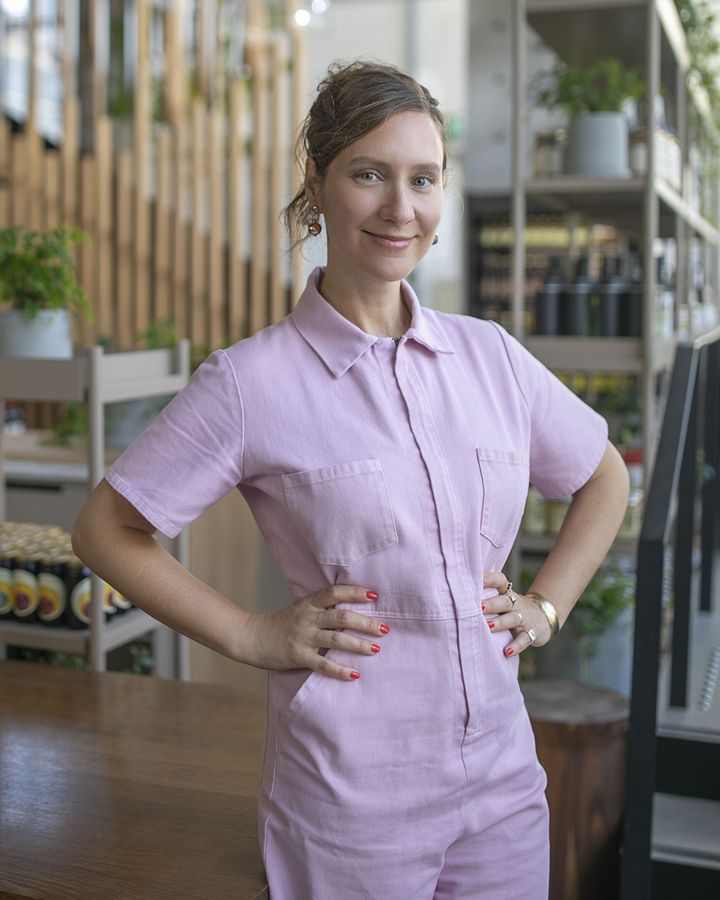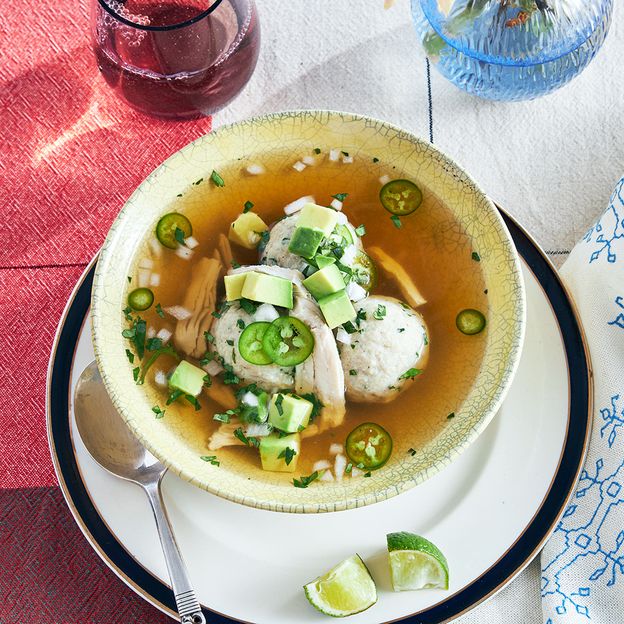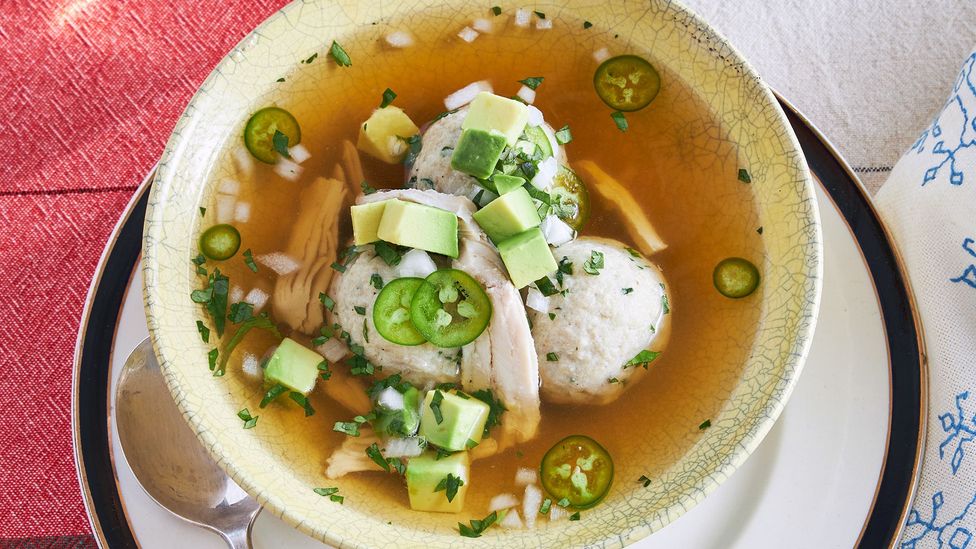Matzah ball soup is a dish with elements that trace back to the Torah, the first five books of the Hebrew bible. Biblical Israelites carried matzah – unleavened bread that resembles a large, thin cracker – out with them from Pharaoh's Egypt during the Exodus, when the Jewish people were liberated from slavery. Jews, under instructions from God, have eaten matzah ever since during the Passover Seder (held this year on 22 April through 30 April), a symbolic, ritual feast that includes a retelling of the biblical story.
Like so many historic, cultural foods, it's difficult to pinpoint the exact moment when Jews started grinding matzah to make the matzah meal used for the balls eaten in the soup. But the Yiddish name (kneidlach) points to Eastern Europe, where you can find similar bread dumplings, like the German Knödel. Instead of using day-old bread, however, Jews mixed matzah meal with eggs, water and schmaltz (typically goose or chicken fat) before cooking the balls in hot water. The matzah balls would then be served in chicken soup, creating what many lovingly refer to now as "Jewish penicillin".
It is the quintessential dish of Ashkenazi Jewry (those with roots in Central and Eastern Europe), served during Shabbat (the sabbath) and Passover. Besides its ancient ancestral connection, the soup is a soul-soothing comfort dish that many Jews remember fondly from their childhood. That's certainly the case for Fany Gerson, founder of the New York City-based catering company and food truck, La Newyorkina.
Gerson grew up in Mexico City, which today has a small population of Jews. The first-known Jewish settlers in Mexico were Conversos, or secret Jews, fleeing the Spanish Inquisition in the late 15th through early 16th Centuries. Over time, the community grew, especially with waves of immigration in the 19th and 20th Centuries from the Middle East and Eastern Europe. Gerson's great-grandmother, for example, emigrated from Ukraine in 1926. That Eastern European Jewish culinary legacy continues through Gerson.
"I've always loved the soup," she says. "And my grandmother had it often, not just during the High Holidays."
Gerson grew up eating a clear, flavourful chicken broth and small matzah balls that were very hard – a stark contrast to the larger, fluffier variety popular at most Jewish-American delis.
"You could almost eat [the matzah ball] with a fork and a knife," she said. "But [my family and I] love them."

The Jewish Holiday Table is by Naama Shefi and The Jewish Food Society (Credit: Tomer Appelbaum)
Gerson became familiar with the New York-style matzah ball when she moved to the city. At first, she thought the delis didn't know how to properly make matzah balls. Over time, she realised that maybe it was her grandmother who had the unique spin.
Instead of shunning one style over the other, Gerson developed her matzah ball soup a la Mexicana. She blended Mexican flavours such as chillies, coriander and avocado in a traditionally Ashkenazi Jewish soup to embrace both traditions.
As for the matzah ball itself, she says, "It took a long time to get that texture that I wanted. It's kind of a cross between both [firm and fluffy], and the size as well." For the best results, Gerson likes to have her eggs at room temperature and adds in a combination of parsley, cilantro, dill and chives. But she's not a stickler about the herbs. "Sometimes I only have two of them," she says. "And that's okay."
Gerson prepares her broth ahead of time, maybe a day or two before she's planning to make the matzah balls. It makes meal prep all the more manageable when all you have to do is make the matzah balls and add the garnish.
More like this:
• The food legacy of a Holocaust survivor
• Purim's iconic jam-filled biscuits
• A return to vegetarian Jewish cuisine
The recipe features in the March 2024 cookbook, The Jewish Holiday Table: A World of Recipes, Traditions & Stories to Celebrate All Year Long, a compilation of 135 holiday recipes from Jewish tables across the globe. In addition to Gerson's Ukrainian Mexican Seder, there is a menu for a Persian Rosh Hashanah feast and an Iraqi spread for Purim.
"The book is really a love letter to our diverse culinary heritage," says author Naama Shefi, an Israel-born kibbutznik turned New York City-based founder of the Jewish Food Society, a non-profit organisation tasked with preserving and celebrating Jewish culinary heritage. "It's a celebration of holiday traditions, from families all around the world."
The book follows the Jewish agricultural calendar, with each holiday featuring four or five family tables, stretching from Soviet Jewry to Morocco and Yemen.
"We really try to emphasise the incredible diversity [of the Jewish people]," says Shefi.

This take on matzah ball soup includes Mexican flavours such as chillies, coriander and avocado (Credit: Penny De Los Santos)
Matzah Ball Soup a la Mexicana with Chiles and Cilantro recipe
By Fany Gerson
Makes: 6 to 8 servings; about 24 matzah balls
Matzah ball soup isn't meant to be a stressful dish to prepare. After all, Gerson describes her recipe as "very user-friendly", even if you've never made matzah ball soup before. When it comes to cooking the matzah balls, Gerson suggests using an ice cream scoop to measure out the mix for each ball, putting a little water on your hands to form them so they don't stick to your skin, and then boiling them all at the same time.
Ingredients
For the broth:
1 large whole chicken (2.2-2.7kg / 5-6lbs) or 1 smaller chicken plus 8 chicken wings
1½ white onions (about 225g / 8oz), halved
4 medium carrots (about 225g / 8oz), peeled and sliced into 6mm (¼in) rounds
3 celery stalks (about 170g / 6oz), cut into large chunks
1 leek, split lengthwise, rinsed well, and thinly sliced
1 or 2 serrano or other hot fresh chillies, halved lengthwise
1 large garlic clove
2 bay leaves
8 coriander stems
8 flat-leaf parsley sprigs
2 epazote sprigs (optional)
1 tbsp kosher salt
5 or 6 whole black peppercorns
about 4L (4 qts) water
For the matzah balls:
5 large eggs
1¼ cups (145g / 5oz) matzah meal
2½ tsp kosher salt
¼ tsp freshly ground black pepper
½ tsp baking powder
½ tsp baking soda
¼ cup melted schmaltz, duck fat, bone marrow or vegetable oil
¼ cup (30g / 1oz) finely grated white onion
3 tbsp finely chopped fresh herbs, such as dill, flat-leaf parsley and chives
For the garnish:
1 small white onion (about 85g / 3oz), finely chopped
2 serrano chillies or 1 jalapeño, cored, seeded, and finely chopped
1 cup (30g / 1oz) chopped fresh coriander
1 or 2 avocados, halved, pitted, peeled and diced
3 or 4 limes, cut into wedges
Method
Step 1
Make the broth. Put the chicken in a large stockpot (at least 10 litres capacity) and add the onions, carrots, celery, leek, chili, garlic, bay leaves, coriander, parsley, epazote (if using), salt, peppercorns and water. If the water doesn't cover the ingredients, add more to cover.
Step 2
Bring the water to a boil over medium-high heat and then quickly adjust the heat so the broth will simmer when partially covered. Partially cover the pot and simmer until the chicken is fully cooked, 50 to 60 minutes, skimming off the foam as needed. Remove from the heat.
Step 3
Carefully remove the chicken (and wings, if using) from the broth and transfer to a bowl to cool. When the chicken is cool enough to handle, pull off the meat, shred it and set aside in a bowl. Discard the skin.
Step 4
Return the chicken bones to the pot and continue cooking the broth at a simmer for another 1 to 2 hours, adding more water if needed to keep the ingredients covered. Remove the pot from the heat and let the broth cool slightly, then strain it into a clean pot and set aside; discard the chicken carcass and the vegetables.
Step 5
Make the matzah balls. Separate 3 of the eggs, putting the whites into a large grease-free bowl and making sure no yolks get into the whites; reserve the yolks in a small bowl. In another large bowl, combine the matzo meal, salt, pepper, baking powder and baking soda and whisk to blend.
Step 6
In a medium bowl, whisk the 2 whole eggs with the 3 yolks, the schmaltz, grated onion and herbs. Beat the egg whites by hand or with a handheld electric mixer until firm peaks form. Stir the schmaltz mixture into the matzah meal mixture, then fold one-third of the beaten egg whites into the mixture until incorporated; the mixture will seem stiff at first but will loosen as you add more whites. Gently fold in the remaining whites until no streaks remain. Press a sheet of plastic wrap directly against the surface of the batter and refrigerate for about 30 minutes, until firm.
Step 7
Fill a small bowl with water and set near your work surface. Scoop up rounded tablespoons (20g) of the matzah batter and arrange them on a baking sheet. Moisten your hands with water and roll each scoop of batter into a ball, handling them as gently as possible.
Step 8
Taste the broth and adjust with more salt if needed, then bring to a simmer over medium high heat. Add the matzah balls as gently as possible and cook in the simmering broth, turning them a few times, until they are plump and cooked through, about 30 minutes.
Step 9
Stir the shredded chicken into the soup and simmer just until it is warmed through. Put a few matzah balls in each soup bowl and ladle in the broth and chicken. Offer the garnishes at the table so diners can serve themselves.
Excerpted from The Jewish Holiday Table by Naama Shefi and the Jewish Food Society (Artisan Books). Copyright © 2024. Photographs by Penny De Los Santos.
BBC.com's World's Table "smashes the kitchen ceiling" by changing the way the world thinks about food, through the past, present and future.
--
Join more than three million BBC Travel fans by liking us on Facebook, or follow us on X and Instagram.
If you liked this story, sign up for The Essential List newsletter – a handpicked selection of features, videos and can't-miss news delivered to your inbox every Friday.
